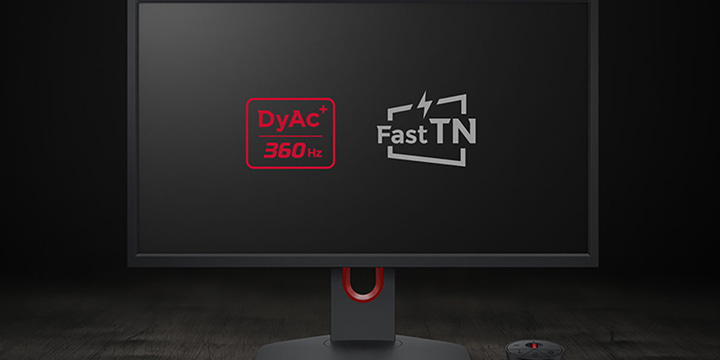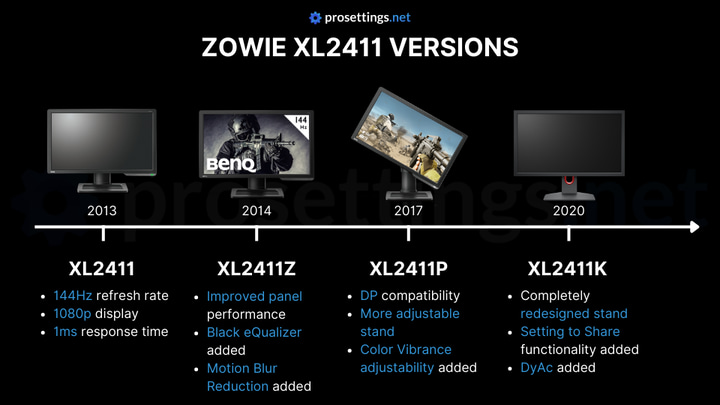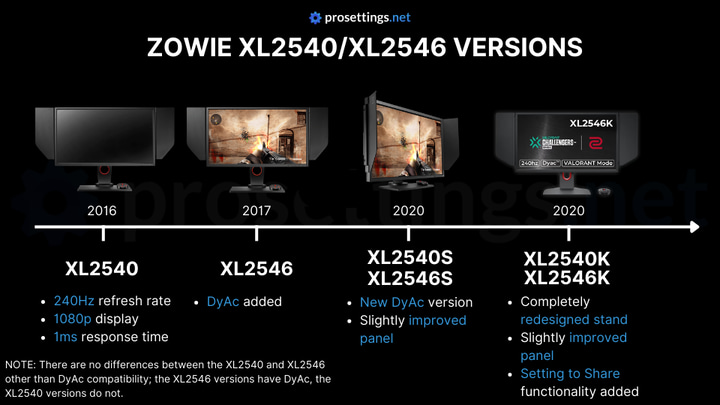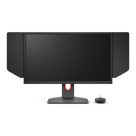The Differences Between ZOWIE monitors

When it comes to gaming monitors, ZOWIE is without a doubt one of the most important brands in the professional gaming scene. Everyone from tournament organizers to professionals playing in lower tier teams are using their monitors, and with ZOWIE monitors being among the most recommended for competitive gaming we’re getting a ton of questions from people about the differences between ZOWIE monitors.
In this article, we’ll go over the features of the most popular ZOWIE gaming monitors so that you can make an informed decision on your next purchase. We’ll also give you some background information on why a ZOWIE monitor might be worth the investment if you’re a competitive gamer.
What makes ZOWIE monitors so good for competitive gaming?
Getting a high refresh rate monitor (click here for our guide on why higher refresh rates are so much better for gaming) is going to improve your consistency as a player, that’s a fact. Less than 1% of our analyzed professionals are a monitor with a refresh rate lower than 144Hz, so there is absolutely no discussion about the fact that a high refresh rate panel is pretty much required for serious competitive gamers.
Just like with any product segment, there are good and and products, though. Things like response times and motion clarity greatly vary between different products, so it’s not a simple matter of just getting a monitor that says ‘high refresh rate on the box’ if you want to get the best of the best. When it comes to pure gaming performance, ZOWIE monitors are top tier thanks to their fantastic backlight strobing technology making for an extremely smooth and clear image as well as their very low response times. In addition to that, ZOWIE monitors also offer a bunch of other gaming-centric features such as Black eQualizer and the ability to adjust the color vibrance on the monitor itself. Newer models also feature XL Setting to Share, letting you export and import settings profiles.
In a nutshell: when it comes to pure performance, ZOWIE monitors are simply among the very best out there, and they have been for years. With that being said, it should also be noted that these monitors are very much geared towards performance. If you’re looking for beautiful colors and extremely detailed blacks, you’re better off going for other monitors, as ZOWIE makes no compromises when it comes to the gaming performance. All of these monitors use TN panels, which are extremely fast and responsive, but aren’t known for their picture quality. These monitors are made for competitive gamers, not for people who only game for an hour or two ever month.
ZOWIE XL2411 – The Budget Option
The ZOWIE XL2411 line was first released in 2013, and ever since its release it has served as the entry level line of ZOWIE monitors. This is a perfect option if you’re rocking a budget machine or if you can’t justify the price for the higher tier models, and with this line getting frequent updates you’re also not buying outdated technology should you decide to go for an XL2411.
XL2411 (2013)
The ZOWIE XL2411 was released in 2013. It has a resolution of 1920x1080p, a 24″ display, and a refresh rate of 144Hz.
XL2411Z (2014)
Shortly after the release of the XL2411, a revision was released. The XL2411Z has an updated panel, with slightly better colors and contrast performance. It also features Black eQualizer and Motion Blur Reduction.
XL2411P (2017)
The XL2411P introduced the ability to adjust Color Vibrance on the monitor itself. It also added Display Port compatibility and a readjusted stand with better height and angle adjustments.
XL2411K (2020)
Bringing the XL2411 family of monitors in line with ZOWIE’s higher tier offerings, the XL2411K has a completely readjusted stand with a much smaller footprint. In addition to that, it also comes with Setting to Share functionality and DyAc, an improved version of ZOWIE’s older Motion Blur Reduction technology. The OSD menu has also been revamped completely, and the K version is compatible with the S-Switch for easier navigation of said OSD, though the S-Switch isn’t bundled with the XL2411K.

ZOWIE XL2546 – The Pro’s Choice
Additional Info
Aside from the very first iterations, ZOWIE has historically always released the XL2540 and 2546 monitors together when new revisions come out. There are no differences between the two different iterations; the only difference is that the 2546 versions comes with DyAc while the XL2540 does not come with DyAc.
The ZOWIE XL2540/XL2546 line is the brand’s most used and most loved esports line. These monitors are being used in a bunch of top tier tournaments, whether officially or unofficially (once you know what to look for, it’s easy to spot a ZOWIE monitor with the logos covered) and are used by a ton of professional gamers. If you’re looking for a 240Hz monitor dedicated to competitive gaming, this is where you should be looking.
XL2540 (2016)
The XL2540 was ZOWIE’s first 240Hz gaming monitor aimed at competitive and professional esports players. It has a resolution of 1080p, a refresh rate of 240Hz, and a 24″ display.
XL2546 (2017)
The XL2546 is a (kind of) successor to the XL2540. It’s pretty much the same in many ways, but the XL2546 introduces DyAc to the monitor line. The S-Switch was also debuted, which is a controller for easier OSD navigation.
XL2540S + XL2546S (2020)
The S line of monitors is a peculiar line. It was only available for a very limited amount of time in 2020 before being replaced by the K line. The S line of monitors has a slightly improved panel as well as a new version of DyAc, but other than that there are no major changes between the previous version and the S version.
XL2540K + XL2546K (2020)
Only a couple of months after the release of the S, the K line was announced. This features a redesigned stand with a much smaller footprint along with a revamped OSD, a slight panel improvement, and the ability to use ZOWIE XL Setting to Share.

ZOWIE XL27 Series – Large Versions
The XL27 line of monitors isn’t very popular in the professional scene, but they are a handy option for people who want a larger screen. They follow the same update schedule as the XL2546 line. The XL2731 is a 27″ monitor with a 165Hz refresh rate, while the XL274x line has a refresh rate of 240Hz.
ZOWIE XL2566K – 360Hz
It took ZOWIE a while to release their own 360Hz monitor, but the XL2566K is exactly that: a 360Hz version of the beloved ZOWIE monitor. This one is reserved for extremely dedicated competitive gamers as it takes a lot of computing power to even reach the necessary framerates to get the most out of this monitor. It’s also pretty pricey, so if you’re someone who wants a compromise between performance and visuals there are way better options out there, but if performance is all that matters to you and you want to extract every percentage point of performance from your rig, then the XL2566K is a great option that’s also getting picked up by professional gamers.
ZOWIE XL2566K
Used by 440 players ()If you are a competitive gamer who takes their game extremely seriously and you want to get the fastest and smoothest gaming monitor to help you be the best player you can be, then you have to get the ZOWIE XL2566K right now.
Pros
- 360Hz refresh rate along with fast TN panel makes it one of the smoothest monitors out there
- Subtle design
- Small footprint of the base
- Lots of QoL features such as the stand markings, the S switch, the included (and detachable) glare panels, …
- Picture quality is great for a TN panel…
Cons
- … but it doesn’t match IPS panels when it comes to quality
- Expensive for a 1080p monitor
- Low viewing angles
Specs
| Size | 24.5″ |
|---|---|
| Resolution | 1920×1080 |
| Aspect Ratio | 16:9 |
| Refresh Rate | 360 |
| G-Sync | No |
| FreeSync | No |
| Panel Tech | TN |
Which ZOWIE Monitor To Get
There might be many iterations of ZOWIE monitors out there, but as of right now there are basically only five monitor lines you need to choose from if you’re only picking from the latest iterations of each monitor line:
Each of these monitor lines has pretty distinct features, so you should be able to find a monitor that suits your exact preferences. For the majority of competitive gamers, we would recommend the XL254x line of monitors; it is a fantastically performing esports display that has been (and is being) used by an impressive amount of professional gamers, and its pure gaming performance within the 240Hz space is absolutely top tier.
For players with deeper pockets and a top tier PC, the XL2566 line is a good option. With its 360Hz refresh rate it’s even more responsive and faster then the 240Hz ZOWIE monitors, but you will have to pay a premium for that performance. If you’re on a budget or you’re using a lower tier PC, consider the XL2411 line.
There is a ZOWIE monitor out there for pretty much every budget and PC, so hopefully this guide has helped you, but if you have any questions please feel free to reach out to us!









